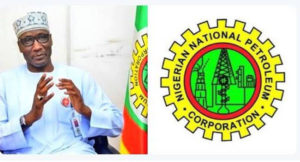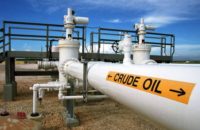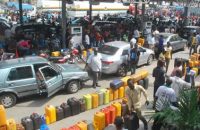
Mele Kyari
…Cost of repairs set to hit N1tr
…Why pipeline vandalism persists
Nigeria’s cost of pipeline repairs and management may soon hit N1 trillion as facilities were damaged 9,420 times in five years, as vandals steal oil and gas. This sum and other recorded losses could build a refinery with the capacity to refine 650,000 barrels per day if the five-year leakage were saved.
The statistics on pipeline vandalisation and billions of naira spent on repairs particularly raises critical questions about the effectiveness, or otherwise, of the Federal Government’s subsisting multi-billion-naira pipeline surveillance scheme, the contracts of which were awarded by the Nigerian National Petroleum Corporation (NNPC).
Rough estimates put Corporation’s pipeline security contracts with various companies at N9.3 billion. In 2018, a well-known award of surveillance contract to an indigenous firm for the protection of the strategic 87-kilometre Trans Forcados Pipeline (TFP) was valued at about $18.4 million (about N7 billion).
With this level of leakage on pipelines alone, the country’s annual budget, revenue base, as well as execution of other developmental plans may still remain elusive.
As of June 2020, the country recorded a total of 9420 pipeline vandalisations, leading to disruption of activities in the upstream and downstream sectors.
A total of 1,067 vandalised points was recorded between June 2019 and June 2020, according to the NNPC, while between January 2015 and June 2019, pipelines were vandalised a total of 8,353 times.
LAST year, despite the award of multimillion-dollar pipeline surveillance contracts to private security companies, there was a loss of 22 million barrels of crude oil between January and June.
The vandalism incidents, according to NNPC reports in five years, were recorded in Mosimi (Ogun state), Kaduna, Port Harcourt, Warri and Gombe. Vandal activities at the Atlas Cove-Mosimi and Mosimi-Ibadan have increased in recent times, with notable incidents recorded this year in Lagos alone.
Between January 2015 and June 2019, the Federal government said it spent over N556 billion on oil pipeline repairs and maintenance across the country. This figure is contained in the monthly financial and operations reports released by the NNPC.
The Corporation disclosed that N118.61 billion was spent on pipeline repairs and management in 13 months, between May 2019 and May 2020; while N34.89 billion worth of petroleum products were stolen in the same period. N6.24bn was however expended in June this year on repairs.
The NNPC, last May, recorded a 43 per cent drop in cases of willful damage of its oil pipeline infrastructure by suspected thieves.
The May 2020 version of the NNPC Monthly Financial and Operations Report (MFOR) indicated that 37 pipeline points were vandalised. This represents about 43 per cent decrease from the 65 points recorded in April 2020.
The NNPC, however, stated that it was collaborating with local communities and other stakeholders to curtail this menace.
Though it stated that unauthorised interference was one of the strongest reasons it introduced horizontal directional drilling to the project, stakeholders wanted a review of strategies in protecting oil assets.
For instance, Director-General of the Lagos Chamber of Commerce and Industry (LCCI), Muda Yusuf, urged oil firms and the NNPC to review strategies deployed in the process.
According to him, it was high time operators explored technology to address the security concerns while deepening efforts with communities where they have assets.
While the Stakeholder Democracy Network (SDN) had questioned the nation’s pipeline surveillance contracts calling it a misnomer, many insisted that losses would worsen if the underlying challenges were not addressed.
A report of the Nigeria Natural Resource Charter (NNRC) stated that, in 2016, about ₦3.8 trillion was recorded as losses from crude oil theft, sabotage and pipeline vandalism.
The NNRC findings revealed that, between 2003 and 2013, there was a total of 15, 685 pipeline breaks caused by vandalism. Usually, small ships anchor near pipelines, drill, and siphon crude, which is then taken to larger oil tankers on the high sea. The stolen oil is normally sold in the international market.
Chairman of the Petroleum Technology Association of Nigeria (PETAN), Bank-Anthony Okoroafor, had told The Guardian that there was need for an integrated approach involving host communities and all the people that have a direct impact on oil pipelines.
“People around the area are the first and primary line of defence for the pipeline. Somebody will know that something will happen. “We can put them on monthly rentals to protect the pipelines; a rent aligned with success-based incentives and transparent and accountable needs-based community development,” he said.
Dr. Ndubuisi N. Nwokolo, Team Lead (Research and Policy), Nextier SPD, had also noted that oil pipeline securitisation has not been fully embedded into the country’s security architecture.
While the constitution empowers the Nigeria Security and Civil Defence Corps (NSCDC) to protect critical infrastructure, including pipelines, Nwokolo doubted their knowledge or understanding of pipeline issues.
The last time petroleum products flowed through the pipelines from Port Harcourt in Rivers State to Emene depot in Enugu State, which serves Enugu, Ebonyi, Anambra, Benue, Kogi and parts of Imo states, was in 2005. This was as a result of breakdown in pipelines supplying products to the state.
The degeneration began from what was considered a temporary closure to pave way for maintenance works in the depot, and repair works on pipelines. But by the time the repair works were concluded at the depot, vandals had done so much damage to pipelines linking the depot from Port Harcourt. It was from there that the endless wait for pipeline repairs began.
Investigation by The Guardian revealed that vandalism then occurred in Osisioma in Aba and Nsirimo axis in Abia State; Isiagu in Ebonyi State and Aninri in Enugu State among other places.
The pipelines were abandoned, and marketers resorted to road transport in supplying products from Warri, Port Harcourt and Lagos to the zone and other areas serviced by the depot. It was not until 2013 that efforts were made to rehabilitate the pipelines. That also happened at snail’s speed and dragged till 2015 when a new contractor, the Port Harcourt-based UMT Offshore Limited, was appointed.
It was gathered that the contracting firm, which took over repair and restoration of the pipelines in 2015 concluded work last year, after it was certified that products could move through the pipes again.
An official of the company, who spoke on condition of anonymity, told The Guardian that the pipelines had been put back to use, stressing however that, what might be delaying product supply was the ongoing repairs at the Port Harcourt Refinery.
He said: “Once the refineries start working, there will be a 24 hours flow to Enugu without any issue. We have activated that line — Port Harcourt to Enugu.
On why it took so long to repair the pipes, he stated that their integrity had become weak due to age, adding that their exposure had made them vulnerable to attacks.
He added: “But the current management of NNPC is working out an arrangement whereby a new pipeline will be built from Port Harcourt to Enugu. It was advertised. They want to build a new pipeline because these ones that are there have been there for over 40 or 50 years and their integrity is weak, they are vulnerable to vandalism and attacks. The management of the NNPC is trying to get the refineries back to 90 or 95% optimisation. So, part of the plan is to also renovate the components, which include the pipeline, the depot, and the entire line. So, once that is done, hopefully in another 24 months, we should have a constant flow of products to Enugu. That is the plan.”
Security guards protecting the pipelines from Isiagu in Ebonyi State to Enugu recently protested non-payment of 10 months’ salary. But the official said the delay was as a result of ongoing reconciliation with the NNPC on job execution. He added that the company would pay the security guards as soon as the reconciliation concluded.
IN 2020 alone, Shell Petroleum Development Company and Nigeria Agip Oil Company, both NNPC joint venture partners, have experienced over 150 pipeline ruptures across the South-South and southeast geopolitical zones.
Though the cause of pipeline vandalism range from corrosion of aging pipelines, illegal oil bunkering, and sabotage by aggressive youths, oil firms blame sabotage for the bulk of the cases.
Recently, the Niger Delta Dialogue (NDD) urged the federal government and multinational oil companies to urgently adopt technology, including the use of surveillance drones to stem crude oil theft, which occasion pipeline vandalism.
Government and oil companies were also advised to partner with genuine community stakeholders across the Niger Delta in a manner that is devoid of primordial incentives to militia warlords for surveillance of oil facilities, particularly, pipelines.
Between January and August, NAOC experienced 56 pipeline ruptures mainly in Ogoda/Brass Pipeline, Tuomo/Ogboinbiri delivery gas line, Ebocha 9T flowline, Clough Creek/Tebidaba Pipeline as well as Ogboinbiri/Tebidaba pipeline.
Other pipelines where there were breaches included Azuzuama 1 & 2 flowline, Ebegoro 2T flowline, Oleh 2Ls flowline, Obama flow station flare stack, Ogoda/Brass Pipeline, Tebidaba/Brass Pipeline, Taylor Creek, Tuomo/Ogboinbiri pipeline.
SIMILARLY, Shell, which has the vast majority of pipelines in the South-South, has experienced scores of facility ruptures blamed mainly on sabotage.
Some of Shell’s ruptured pipelines in 2020 alone were Okordia – Rumuekpe Pipeline at Edeoha, Imo River2 – Ogale Pipeline at Umuololo, Imo River Well 59T Flowline at Igiriukwu-Owaza, Nkpoku – Bomu Pipeline at Egbalor, Okordia-Rumekpe Pipeline at Ula-Ikata, Imo River2 – Imo River1 Bulk line at Igiriukwu -Isietitioha – Owaza, Imo River1 – Ogale Pipeline at Okohia.
Others are Kolocreek – Rumuekpe Pipeline at Owerewere, Seibou – Ajatiton Bulkline at Agbidiama, Imo River 1 – Ogale Pipeline at Umuololo, Assa – Rumuekpe Pipeline at Egbeda, Nkpoku -Bomu Pipeline at Rumuewhara, Okordia-Rumuekpe Pipeline at Ukpeliede, Assa – Rumuekpe Pipeline at Awara, Nkali – Ogale Pipeline at Odagwa, Oguta – Assa Pipeline at Opuoma, and Okordia-Rumuekpe Pipeline at Idu-Ekpeye.
Also breached are: Bomu – Bonny Pipeline at Owokiri, Okordia-Rumuekpe Pipeline at Ula-Ikata, Nkpoku – Bomu Pipeline at Rumuowha, 20” Kolocreek – Rumuekpe Pipeline at Odau, Imo River – Ogale Pipeline at Umuololo, Bomu – Bonny Pipeline at Kpor, Kolocreek – Rumuekpe Pipeline at Okoma 1, Nkpoku – Ogale Pipeline at Rumuokwurusi.
Others are Nkpoku – Bomu Pipeline at B-Dere, Nkpoku – Bomu Pipeline at Elelenwo, Egbema – Assa Pipeline at Etekwuru, Imo River Well 55S Flowline at Igiriukwu, Adibawa Well 6T Flowline Flange at Edagberi-Better land, Bonny Well 10S Flowline Riser at Oloma, 20” Kolocreek – Rumuekpe Pipeline at Aminigboko, Kanbo Well 5L Flowline at Tunu, Rumuekpe – Nkpoku Pipeline at Ibaa, Benisede well 24L Bean Box at Benisede among others.
The Guardian

















Comments